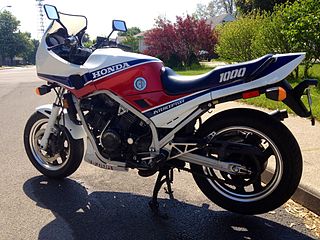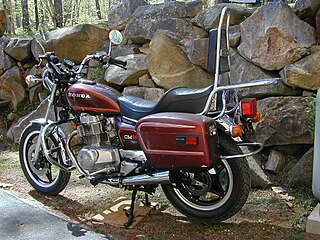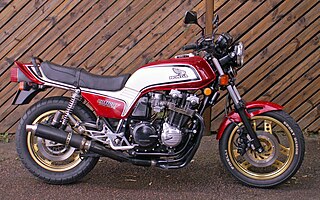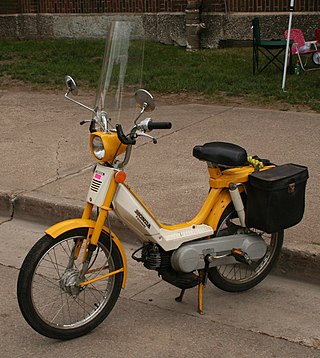
The Honda Magna is a cruiser motorcycle made from 1982 to 1988 and 1994 to 2003 and was the second Honda to use their new V4 engine shared with the VF750S Sabre and a few years later a related engine was fitted to the VF750F 'Interceptor', the later models used a retuned engine from the VFR750F with fins added to the outside of the engine. The engine technology and layout was a descendant of Honda's racing V4 machines, such as the NS750 and NR750. The introduction of this engine on the Magna and the Sabre in 1982, was a milestone in the evolution of motorcycles that would culminate in 1983 with the introduction of the Interceptor V4. The V45's performance is comparable to that of Valkyries and Honda's 1800 cc V-twin cruisers. However, its mix of performance, reliability, and refinement was overshadowed by the more powerful 1,098 cc "V65" Magna in 1983.
The Honda XR series is a range of four-stroke off-road motorcycles that were designed in Japan but assembled all over the world.

The Honda Gold Wing is a series of touring motorcycles manufactured by Honda. Gold Wings feature shaft drive and a flat engine. Characterized by press in September 1974 as "The world's biggest motor cycle manufacturer's first attack on the over-750cc capacity market...", it was introduced at the Cologne Motorcycle Show in October 1974.

The Honda VFR400 series of motorcycles were a related series of 399 cc V4-engined motorcycles, which were essentially scaled-down versions of the larger VFR race models of the day. They were mainly developed for, and sold in, the Japanese domestic market, in part due to the tougher motorcycle drivers' license restrictions in Japan at the time for motorcycles with displacement exceeding 400cc.

The Honda CX series motorcycles, including the GL500 and GL650 Silver Wing variants, were developed and released by Honda in the late 1970s, with production ending in most markets by the mid 1980s. The design included innovative features and technologies that were uncommon or unused at the time such as liquid cooling, electric-only starting, low-maintenance shaft drive, modular wheels, and dual CV-type carburetors that were tuned for reduced emissions. The electronic ignition system was separate from the rest of the electrical system, but the motorcycle could only be started via the start button.

In 1979, Honda introduced a series of light motorcycles in the US and in Europe. Honda's production lines of these models were in Spain, Belgium and Sweden.

The MB50 is a Honda motorcycle known as the MB5 in Canada and the USA, produced from 1979 into the late 1980s. The MB was the road oriented version of the Honda MT50. Sales ended in 1981 in the UK and 1982 in the US, but sales continued in other European countries until 1988.

The VF1000 is a range of motorcycles produced by Honda from 1984 to 1988. The VF1000 is named after its V-4 998 cc (60.9 cu in) double overhead cam 16-valve engine. There were three main models in the VF1000 range, the VF1000F, the VF1000R and the VF1000F2.

The Honda CM400 is a street bike produced by the Honda Motor Company from 1979 to 1982, part of a series of motorcycles with the prefix 'CM' using various engine capacities. It was a precursor to the Honda Rebel series of motorcycles. It was equipped with electric start and electronic ignition. Models included the CM400A, CM400C (Custom), CM400E (Economy) and CM400T (Touring). The CM400C was produced only in 1981, making it one of the rarer models.

The Honda VTX series is a line of V-twin Honda cruiser motorcycles inspired by the Zodia concept shown at the 1995 Tokyo Motor Show. The Honda VTX 1800 was launched in 2001 as a 2002 model. At the time this bike was introduced the Honda VTX engine was the largest displacement production V-twin in the world, but that distinction would be short-lived as the VTX1800 was superseded in 2004 by the 2.0-litre Kawasaki Vulcan 2000. Nevertheless, the VTX 1800 still produced better 0-60 mph and 1/4 mile times.

The Honda CB1100F is a standard motorcycle that was made only in 1983 by Honda, based on their line of DOHC air-cooled inline four engines. Honda introduced the similar CB1100 in 2010.

The Honda Sabre was a motorcycle made by Honda from 1982 to 1985. Two years of the Sabre production run were part of a group of Japanese motorcycles that came to be known as "tariff-busters". The 1984 and 1985 models fell in this class because of the modifications made allowing those models to circumvent the newly passed United States International Trade Commission tariff that placed a heavy tax on import/foreign motorcycles with 700cc or larger engine displacement.

The Honda Eve or Honda Spree or Nifty 50 (NQ50) is a 49 cc (3.0 cu in) motor scooter made by Honda in the 1980s. Honda marketed two more models based on the Eve's design. All models utilized a single geared AF05 engine.

A touring motorcycle is a type of motorcycle designed for touring. Although almost any motorcycle can be used for this purpose, manufacturers have developed specific models designed to address the particular needs of these riders. Touring motorcycles commonly have large displacement fairings and windshields that offer a high degree of weather and wind protection, large-capacity fuel tanks for long ranges between fill-ups, engines with a great deal of low-end horsepower, and a more relaxed, upright seating position than sport bikes.

The VT250 or Spada MC20 is a Honda motorcycle built between late 1988 and the end of 1989.

The Honda CB650 is a 627 cc (38.3 cu in) standard motorcycle produced from 1979 to 1985. It featured a four-cylinder, SOHC, air-cooled, wet sump engine, with two valves per cylinder. The CB650 was a development of the CB550, itself derived from the even earlier CB500. The CB650 was the last of Honda's successful series of air-cooled SOHC fours that began in 1969 with the Honda CB750.

The Honda PA50 is a moped produced by Honda Benelux between 1976 and 1991. It was marketed as the Honda Hobbit in the US and as the Honda Camino in the UK and Europe. The vehicle itself was manufactured in a factory in Aalst, Belgium, until 1991. Though it has mostly disappeared from the streets of the US and the UK like most mopeds of similar type, it remains very popular in Belgium, where it is often modified using high performance parts.

The Honda CB400T is a range of motorcycles built by Honda. In the United Kingdom it was known as the Dream, whereas in the United States it was known as the Hawk. A Honda CB250T version was also available for UK licensing reasons.

The Honda VF750F is a street bike designed by Honda from 1983 to 1985. It has an 86 hp (64 kW), liquid-cooled, V4 engine which sports dual overhead cams (DOHC). The V4's were started a year before with the 1982 Honda Magna VF750C and Sabre VF750S but were adapted for the VF750F in 1983 by reducing the six speed transmission to a five speed because of the change from shaft drive to chain. This reduced the available space in the transmission thus changing to a five speed.

The Comstar wheel, sometimes referred to as Com-stars or stylised as ComStar, was a composite motorcycle wheel that Honda fitted to many of its motorcycles from 1977 to the mid 1980s. Its design allowed it the option of being fitted with tubeless tyres and its use on the Honda CX500 was the first time tubeless tyres had been designed for a production motorcycle.



















